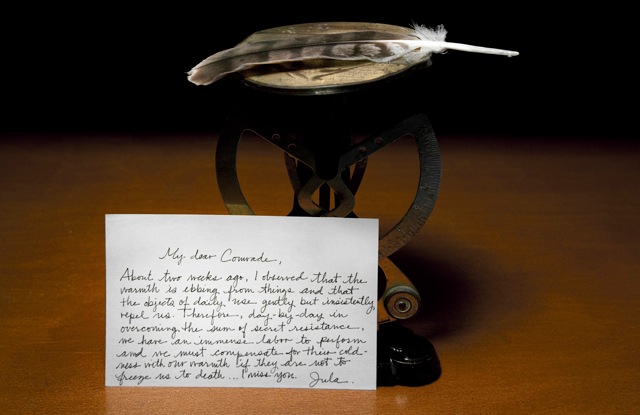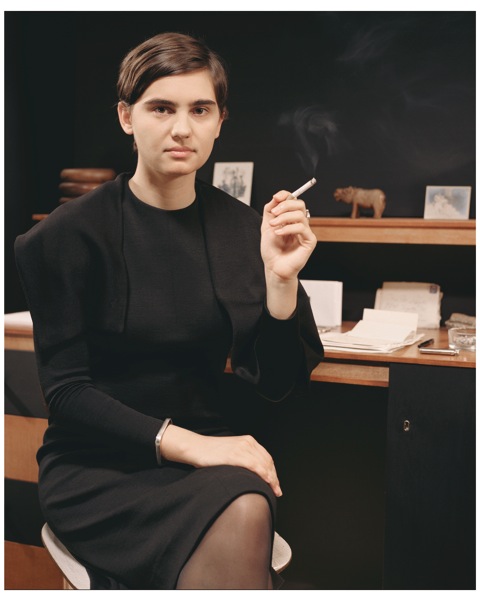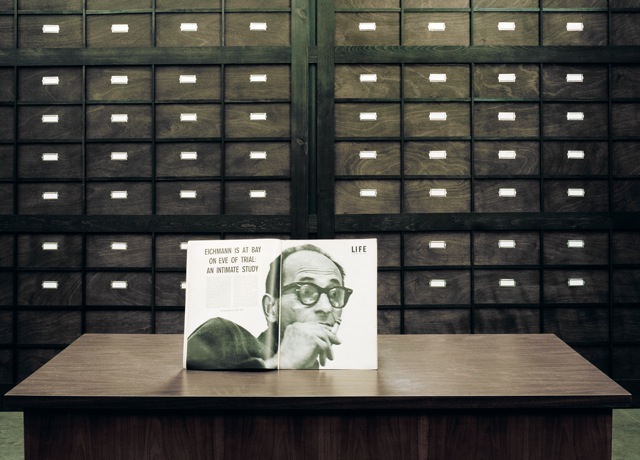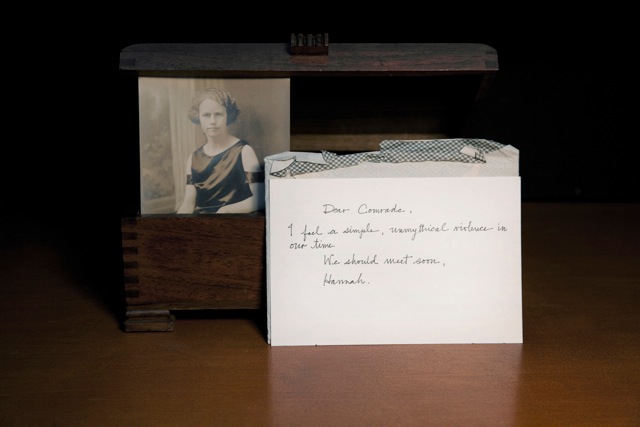
"Imagine to be here, right now. (Comrades of Time)," 2011. Digital C-prints, 20 x 30", color. Courtesy Andrea Geyer.
Through Andrea Geyer’s work we are offered a veritable blow-by-blow of political and social emergencies from the 2000s, in addition to more anachronistic socio-political problems and events that her work confronts. Her video installation, Parallax, for instance, begins an ongoing investigation into the fate of citizenship, foregrounding conditions of displacement among a world population unsettled by governmental responses to 9/11, 2001. Using photographs and texts in tandem, as Geyer explains, “Parallax tries to defamiliarize the ‘naturalized notion of citizenship.’”
The notion of denaturalization, which Geyer attributes to Hegel, may be a fruitful theoretical ground through which to encounter many of her images and texts, where we find a relentless questioning of the world as it exists through common sense. What overturns common sense is the drive for resistance. Geyer’s installations—guided by expertise in photography and research, as well as the tendencies of a storyteller—offer critical sites where common sense can become visible, and where this visibility can open towards the potential for resistance.
In a series of slide projections of airport interiors, one becomes able to reflect on these interiors as built architectural spaces, the projections forcing a remediation of their seamless mental and physical semiologies. In another photographic project, Spiral Lands, we see the mythologized land of the American Southwest demythologized by the doubling of photographic images that make one question the representation of natural spaces haunted by colonial violence and primitive accumulation. The miniscule differences in these photographs act as traces, opening the land to encounters beyond the transcendentalism of the genre originated by Ansel Adams and others.

"Comrades of Time / Anna," 2010-2011. Multi-channel video installation / 7 videos, HD, color, sound. Courtesy Andrea Geyer.
In another set of projects, Geyer revisits “the archive,” hoping that familiar historical sites and documentary materials may once again become strange, therefore open to new readings, constellations, intuitions. She does so in a project devoted to Audrey Munson, a model from the turn of the (19th) century who became one of the most iconic figures of the age through her appearance in numerous sculptural works throughout New York City. Of course Geyer’s research began by simply wondering what a certain sculpture was at the top of the Municipal Building, daydreaming out a window of her studio; her sense of history suddenly shifting through a recognition within familiar urban space.
Archival remediation and revision forms the basis of three more recent works, the last of which is currently on view at MoMA, 9 Scripts from a Nation at War. In Evidence (Criminal Case 40/61), Geyer revisits the trial of Adolf Eichmann. Placing a series of objects related to the trial on a table in front of a wall of archive boxes, her photographs foreground the materialiaty of these objects, how they would seem undeniably particular and yet ciphers for historical inscription. In Comrades of Time, seven of Geyer’s friends re/enact writings and correspondence from the era of the Weimer Republic. As the artist explains, “Through this Brechtian rupture the artist is able to build a space of reflection where an individual internalisation of historical and political knowledge takes place.”
1. What is your background as an artist and how does this background inform and motivate your practice?
We are not simply visual phenomena for each other – our voices must be registered, and so we must be heard; rather, who we are, bodily, is already a way of being “for” the other, appearing in ways that we cannot see, being a body for another in a way that I cannot be for myself, and so dispossessed, perspectivally, by our very sociality. I must appear to others in ways for which I cannot give an account, and in this way my body establishes a perspective that I cannot inhabit.
–from Judith Butler, Bodies in Alliance and the Politics of the Street
Migration, which has been a significant part of my adult life, brings with it a productive understanding of identity, of uncertainty and of “not knowing,” which opens up unexpected perspectives and positions. Of who we are, who we are for others, and how as such we enter the space of the political. I was born in Germany and was raised with the specific consciousness that the history of this country affords. I grew up with the psychological aftermath of fascism and of war, yet economically and socially within a prosperous, open, and progressive environment in which public and free education for all allowed me to receive a university degree. Moving to New York in the mid-1990s these multiple layers of memory were curiously called out by the events and the public response to them that have dominated New York City and the US since then: the AIDS crisis, the Bush administration, 9/11, the invasion into Iraq, torture executed by the US Army, Guantanamo, resistance to the Iraq war, and the current “Occupy” movement, just to name a few. I encounter all of those events and after awhile also those of my upbringing, with the simultaneous intimacy and distance of a migrant consciousness; a curious, multi-faceted space of simultaneous connection and alienation. Memory became the focus of my work: narratives that reach backward and forward in time, manifesting within a person’s experience of the present. I understand memory roughly as constituted of three folds: personal memory of what happened in front of one’s eyes; subconscious memory of things that are transferred often in nonverbal ways by those who raised us; and institutional memory taught to us in schools and other educational institutions of things that we are asked to remember as participants in a community, a nation. In the moment of one’s action they merge and one’s own, specific memory, and as such inform the political as it unfolds through each individual.

"Comrades of Time / Nikki," 2010-2011. Multi-channel video installation / 7 videos, HD, color, sound. Courtesy Andrea Geyer.
2. Do you feel there is a need for the work that you are doing given the larger field of visual art and the ways that aesthetic practices may be able to shape public space, civic responsibility, and political action? Why or why not?
There are many different forms of expression that are named “art” or “culture.” What relates them for me is their potential to offer an experience, a space of reflection, a place to ponder complex issues, to ask difficult but necessary questions, a site of knowledge, a poetic document of the context and time and conditions of their authorship. I think art is needed because it allows a public space inclusive of a complex diversity of ideas and forms that are otherwise difficult to experience, address, or even recognize. As a collective social space it gives possibility for these ideas to reinsert themselves into parts of a public consciousness. I am interested in a public space of (slight) discomfort, unexpected emotions and pleasure that only art can create. Offering an anchoring point, art has the potential to engage places we don’t know or can’t acknowledge—places of uncertainty. It helps us to recognize the fringes of our own comprehension not as a threat but as potential. Art is a collective space, even if the viewing of the work does not necessarily happen collectively. The idea of the shared experience remains with artworks thus framing it as a political site. The viewers appears bodily and socially as vulnerable and incomplete to herself and to others and is invited to understand this condition not as a shortcoming, but a productive site of actions.

Evidence "Evidence (Criminal Case 40/61)," 2010. Digital c-prints. 16 x 22 inches. Courtesy Andrea Geyer.
3. Are there other projects, people, and/or things that have inspired your work? Please describe.
Yes, there are teachers and mentors, lovers, friends and colleagues, opponents, challengers, agitators, strangers, public figures, passer-bys, writers, artists, poets, filmmakers, song writers, radicals, philosophers, cooks, activists, women (lots of them), feminists, civil rights leaders, grandmothers, the original inhabitants of Turtle Island, community organizers, lesbians, dykes, trannies, fags, queers, others without any designation, drop outs, flakes, saints, sinners, ideas, news items, moments – often unexpected –, acts of courage, movements local and afar, present, past and “undiscovered,” collective efforts, sudden encounters, meetings one-on-one and en masse, assemblies, disassemblies and quiet, empty space.

"Imagine to be here, right now. (Comrades of Time)," 2011. Digital C-prints. 20 x 30", color. Courtesy Andrea Geyer.
4. What have been your favorite projects to work on and why?
Besides my collaborative work, which I always find a most fruitful expansion of one’s own capacity to imagine, there are some aspects of my work that I enjoy tremendously. One is the act of what I have called temporal translations, where I work with historic texts/ideas and translate them forward and across time by writing scripts to be read and performed. This process of researching and writing feels like a form of intent and quiet listening for the manifestations of echoes of past events in present moments. I look for them in personal, public and official language and speech. Picking up these echoes has become increasingly relevant in a public sphere that tries to cultivate a collective amnesia. In my temporally translated scripts, I manifest the echoes found in language and speech, opening them up again, reactivate them to be perceived and experienced by and through a singular body: that of the performer and that of the viewer.
I want to allow an active form of remembering, in which I don’t simply present a memory, but create works, which offer the conditions of a renewed, active remembering, even when trauma or neglect would seem to make remembrance impossible.
For my work Criminal Case 40/61:Reverb, 2009, I looked at the transcripts of the 1961 case of Adolf Eichmann, who was the head of the department of Jewish Affairs in the Gestapo. I create a space to think through questions of an individual’s responsibility towards the actions of the state she or he holds citizenship with, questions significantly relevant during the George W. Bush administration. In Comrades of Time, 2011, I looked at a different moment of time, the complex years following World War I and the 1919 revolution in Germany, the Weimar Republic. I had a keen interest in the political imaginary that was so dominant during that time across all fields of life. Everyone felt entitled to imagine how the young republic should be run. The combination of vision and fear, of radical social and political models, and ultra-conservative, traditionalist tendencies echo pointedly with the climate in 2010, one year into the Obama administration. For this project I wrote scripts inspired by personal correspondences, speeches, and essays from 1920s Germany to be embodied by seven young women. I created an abstracted workspace for them, a stylized study situated in shades of black that stand for the abstraction of time, in which I filmed each of them rehearsing and speaking the scripts. This process produced an exciting leap. A young Latina addresses Walter Benjamin’s intricate words through speech directly at me; a 19 year-old student presents the arguments of the 1920s women’s movement fueled by her youthful anger; an androgynous performer reminds us of the origins of the gay liberation movement by speaking through the voices surrounding Magnus Hirschfeld’s visionary institute. Who is talking to whom, when and why, and with what intent? For me and us — as only ever contemporary beings — it is important to recognize these inherent echoes across time and geography, their potential in history and memory that persist through the contemporary.
5. What projects would you like to work on in the future? What directions do you imagine taking your work in?
I have currently started work on two projects. One tracing extremists forms of language that are emerging through broadcast media within the current elections. The religious undertones are particularly interesting to me. Religion has always played a huge part in politics, but in recent years has become increasingly pronounced. In the initial research phase, I am working with possible historic and contemporary implications of such language within a political imaginary. The second project I am researching reaches more specifically into the past and explores the three women who laid the foundation of the Museum of Modern Art: Lilly Bliss, Mary Sullivan and Abby Rockefeller. I am interested in the tension between the act of courage and commitment that was brought forward by these women and the lack of representation of women artists throughout the years of the very same institution they brought forward.






